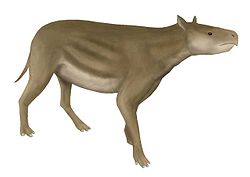Description
Prosantorhinus was a similarly sized animal to the Sumatran rhinoceros, it stood at around 4 ft 3 in (130 cm) at the shoulder and was about 9 ft 6 in (290 cm) long, weight estimates however are considerably bigger due to its considerably deeper chest. [3] The body plan of Prosantorhinus is stubbier than that of other rhinocerotids, and its brachyodont molars would seem to suggest Prosantorhinus led a semiaquatic life, similar to a hippopotamus, possibly feeding on fresh water plants. [4] [5] The tooth eruption sequence of P. germanicus was identical to that of the present-day black rhinoceros, suggesting that it was a slow-growing and long-lived mammal. [6] The rugged texture at the tip of its snout could suggest the existence of one, maybe two, small horns; however it has been traditionally reconstructed with a fleshy bump. [7]
This page is based on this
Wikipedia article Text is available under the
CC BY-SA 4.0 license; additional terms may apply.
Images, videos and audio are available under their respective licenses.









